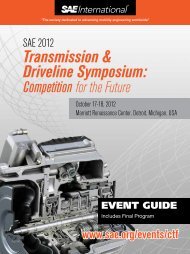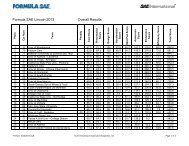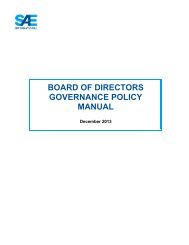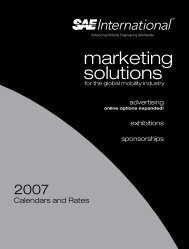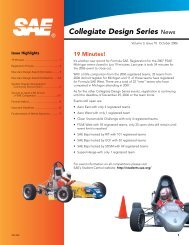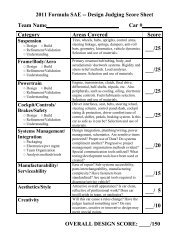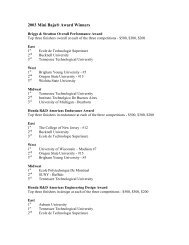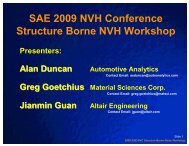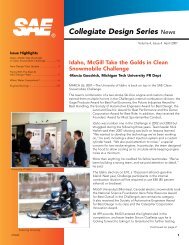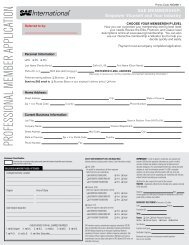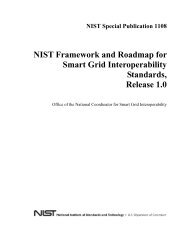Formula SAE A Guide to Meeting the Structure Equivalency ...
Formula SAE A Guide to Meeting the Structure Equivalency ...
Formula SAE A Guide to Meeting the Structure Equivalency ...
You also want an ePaper? Increase the reach of your titles
YUMPU automatically turns print PDFs into web optimized ePapers that Google loves.
3.3.4.2 Main Roll Hoop Attachment <strong>to</strong> Monocoque<br />
Proving equivalency of <strong>the</strong> main roll hoop attachment can be trickier than showing equivalency of<br />
<strong>the</strong> roll hoop itself. Rule 3.3.4.2 states that <strong>the</strong> main roll hoop must be attached with an adequate<br />
number of 8mm bolts and 2mm thick (backing) plates. Use of adhesive as additional structural<br />
transfer is acceptable, but we want <strong>to</strong> ensure that <strong>the</strong> main roll hoop is structurally attached with<br />
mechanical fasteners that we can verify at Technical Inspection. The quantity, location and<br />
design details of <strong>the</strong> main hoop attachment, including drawings, must be provided with supporting<br />
calculations.<br />
3.3.4.3 Front Roll Hoop<br />
Composites are not allowed for Front Roll Hoops. They must be closed section metal tubing, and<br />
must be connected securely <strong>to</strong> your monocoque. Closed section includes round, near round, box<br />
and o<strong>the</strong>r tubing shapes that form a closed cross section. Make sure your design does not fall<br />
below <strong>the</strong> minimum wall thickness given in <strong>the</strong> rules (3.3.3.2 Alternative Tubing and Material),<br />
and has sufficient area, modulus and material properties.<br />
Unlike <strong>the</strong> Main Hoop, Rule 3.3.4.2 does not govern <strong>the</strong> front roll hoop attachment. Use of<br />
adhesives is acceptable, if <strong>the</strong> hoop is completely contained in composite and <strong>the</strong> ply material<br />
and adhesives are demonstrated <strong>to</strong> have sufficient strength. The design details of <strong>the</strong> main hoop<br />
attachment, including drawings, must be provided with supporting calculations.<br />
Remember, your main roll hoop and front roll hoop must have an exposed portion with inspection<br />
holes for determining diameter and wall thickness.<br />
3.3.5.1 Main Roll Hoop Bracing<br />
The rules dictate a steel closed-section main roll hoop bracing. Additionally, provide detailed<br />
information on <strong>the</strong> manner of <strong>the</strong> bracing attachment. If <strong>the</strong> bracing is welded in<strong>to</strong> <strong>the</strong> structure at<br />
both ends it is not considered mechanically attached. The bracing is considered mechanically<br />
attached if fasteners are used at one or both ends, regardless if <strong>the</strong> team has any intention of<br />
disconnecting <strong>the</strong> attachment while at <strong>the</strong> competition. Section 3.3.5.5 (Mechanically Attached<br />
Roll Hoop Bracing) should be referenced which outlines acceptable methods of fastening <strong>to</strong> a<br />
space frame.<br />
New in 2008 is <strong>the</strong> following phrase near <strong>the</strong> end of 3.3.5.1:<br />
“Bracing loads must not be fed solely in<strong>to</strong> <strong>the</strong> engine, transmission or differential, i.e. <strong>the</strong><br />
bracing must terminate at a node where <strong>the</strong>re is a load path through <strong>the</strong> Primary<br />
<strong>Structure</strong>.”<br />
The basic test that will be applied for 2008 and beyond for <strong>the</strong> Main Hoop Bracing is that with <strong>the</strong><br />
engine and transmission removed, <strong>the</strong>re must be a load path, made from approved sized steel<br />
tubing, from <strong>the</strong> bot<strong>to</strong>m of <strong>the</strong> Main Hoop Bracing back <strong>to</strong> <strong>the</strong> Main Hoop. The minimum<br />
dimensions of approved steel tubing are 1.00” OD x 0.049” wall. Preferably it would be 1.00” OD<br />
x 0.065” wall.<br />
If you want <strong>to</strong> use part of a Powertrain component (such as a homemade differential casing)<br />
anywhere in <strong>the</strong> load path you will need <strong>to</strong> show equivalency with that component and all<br />
interconnecting components back <strong>to</strong> <strong>the</strong> main roll hoop. You have <strong>to</strong> show equivalency against<br />
<strong>the</strong> 1.00” OD x 0.049” steel tube that is required.<br />
If attaching <strong>to</strong> a monocoque, please see section 3.3.5.3 as all Main Hoop <strong>to</strong> monocoque<br />
attachments are by definition Mechanically Attached.<br />
SEF_<strong>Guide</strong>_2008.doc / B. Riley 3 11/6/2007



